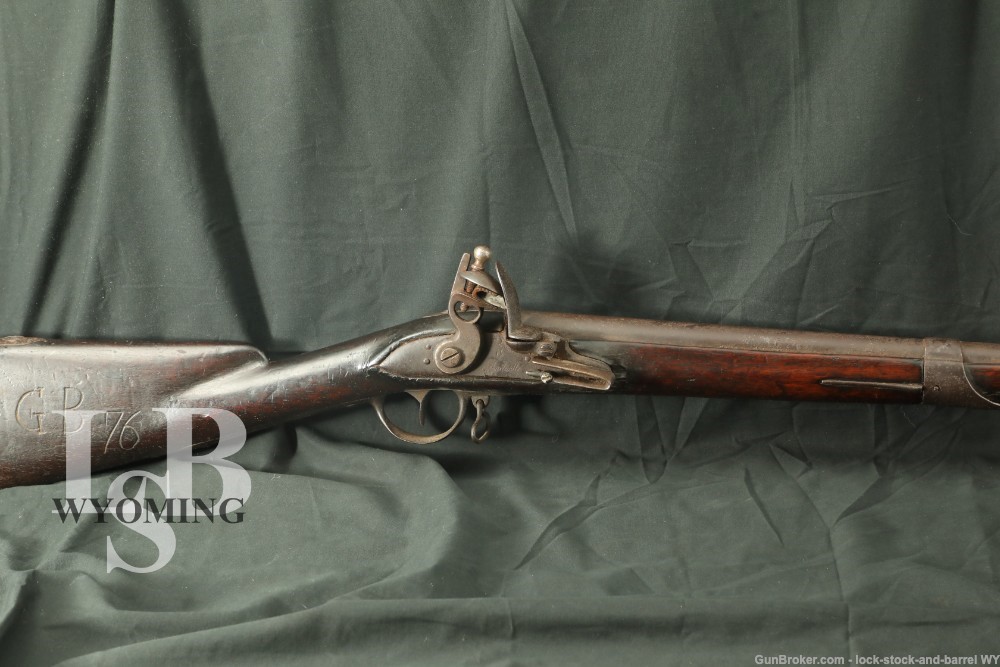
Charleville Model 1766 Musket .69 Cal Flintlock Musket Antique
SOLD FOR: $1,800.00
WOA#: WY240323WM001
Make: Royal Manufacture of Charleville, Maubeuge Arsenal
Model: Model 1795 Musket
Serial#: NSN
Year of Manufacture: 1766
Caliber: .69 Cal
Action Type: Muzzleloader, flintlock
Markings: The lock plate is marked “CHARLEVILLE”, with a ”D” or a “B”, . The left side of the barrel is marked “P”, The right side of the buttstock has been carved with “GB76”
Barrel Length: 44.5”
Sights/ Optics: The front sight is a shallow blade. There is no rear sight.
Stock Configuration & Condition/ Grip: The wood stock has a straight grip, metal nose cap with cut out for the included ramrod, barrel band with sling loop, barrel band, trigger guard assembly mounted sling loop, and metal buttplate. The buttplate is covered in oxidation and there are areas of pitting throughout. There are compression marks, scuffs, and scratches throughout the wood. There are no cracks to be seen . There is wear along the edges of the ramrod channel. The LOP measures 12.5” from the front of the trigger to the rear of the buttplate. The stock rates in about Fair overall condition for an antique.
Type of Finish: Patina/ Rust
Finish Originality: Original
Bore Condition: The smoothbore is dark with even rust and stubborn fouling throughout. There is no visible heavy pitting present.
Overall Condition: The finish on all the metal parts has turned to a patina. There are scuffs, scratches, and areas of oxidation throughout. There is tarnish to the brass on the powder plate cover as well as a large amount of verdigris. The screw heads show moderate to heavy use. The markings are worn from time and the patina. Overall, this rifle rates in about fair condition.
Mechanics: The action functions correctly. But has definite trouble staying locked on the cocked and half cock position. We did not fire this musket. As with all used firearms, a thorough cleaning may be necessary to meet your maintenance requirements.
Box Paperwork and Accessories: The musket comes with a piece of gunflint and a ram rod installed.
Our Assessment: (Reference Wiki) Marin le Bourgeoys created the first true flintlock weapons for King Louis XIII shortly after his accession to the throne in 1610.[2] Throughout the 17th century, flintlock muskets were produced in a wide variety of models.
In 1717, a flintlock musket for the French infantry was standardized. This became the first standard flintlock musket to be issued to all French troops. While it is more correctly called a French infantry musket or a French pattern musket, these muskets later became known as “Charleville muskets”, after the armory in Charleville-Mézières, Ardennes, France.[3] The standard French infantry-long gun was also produced at Tulle, Saint-Étienne, Maubeuge Arsenal, and other sites. While technically not the correct name for these muskets, the use of the name Charleville dates back to the U.S. Revolutionary War, when Americans tended to refer to all of the musket models as Charlevilles. The naming of these muskets is not consistent. Some references only refer to Model 1763 and later versions as Charleville flintlock muskets, while other references refer to all models as the Charleville. The Charleville musket’s design was refined several times during its service life. Later models of Charleville muskets remained in service until 1840, when percussion lock systems made the flintlock mechanism obsolete.[4]The Model 1763’s sturdier design proved to be a bit too heavy, so in 1766 the musket’s design was lightened. The barrel wall was thinned, the lock was shortened, the stock was slimmed, and the Model 1763’s long iron ramrod cover was replaced by a pinned spring under the breech. The trumpet shaped ramrod of the Model 1763 was also abandoned in favor of a ramrod with a lighter button shaped end.Though usually considered to be a separate model, the Model 1766 was often referred to as a “light Model 1763” musket, especially in Revolutionary War invoices.[5] Despite being thinned down, the Model 1766 proved to be rugged and reliable. A total of 140,000 Model 1766 muskets were produced.
The finish on the metal has been almost entirely converted to a patina and the brass on the lock plate has areas of tarnish. The smoothbore has rust and fouling throughout, though there does not appear to be any heavy pitting. Given the condition of the stock, shooting this musket would perhaps be inadvisable. Despite that, this is a good example of the first mass produced long arm, a 250 year old one at that. Please see our high quality photos and enjoy the auction. -K.F.

